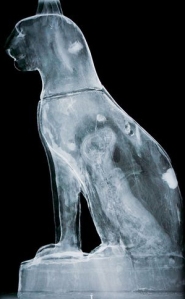In an article decrying (with some justification) the tendency of animal-rescuing persons to refer to animal-breeding persons with derogatory names, the author stated (emphasis theirs):
Animal shelters in the USA have been casting a wide net to fill their kennels for years. According to the US Public Health Service, Chicago O’Hare was the destination airport for 10,125 dogs imported from overseas in 2006, half of which weren’t vaccinated. Scientists from the Center of Disease Control estimated that over 199,000 dogs (38,100 unvaccinated) came into the country through the Mexican border that year alone, and in 2007, one organization in Puerto Rico by itself shipped more than 14,000 strays in seven years to the United States for adoption at shelters. ABC News reported that according to G. Gale Galland, veterinarian in the CDC’s Division of Global Migration and Quarantine, as many as 300,000 puppies a year – most from countries with little or no health safeguards, are being imported to satisfy the demand for puppies at shelters.
This set off my WTF detector, because, in my experience, I think the last thing the workers at the shelter where I work would ever want to do would be to purchase, with money, more animals for the shelter. People walk in their door every day with baskets of puppies, often purebred. At this exact second they have four purebred Beagles, a purebred German Shepherd, a Labrador retriever, a handsome white Boxer, and a mother Pug with two puppies. Speaking of puppies, there is also a litter of five little Lab/Beagle mixes, at least three other, single, puppies, and some lovely juvenile (teenage) dogs, as well as possibly an infinite number of kittens. Every cage is full. For what possible reason would they want to ask for more dogs?
The original G. Gale Galland quote, in a 2007 article about how importation of unvaccinated dogs is prompting concerns about rabies, does indeed say that “as many as 300,000 puppies a year” are being imported — but it does not say that all the animals are specifically going to shelters. Two paragraphs down in the same article, the Border Puppy Task Force in California describes the puppies as being “sold for $1,000 each in shopping center parking lots on the street”. The Task Force web site exhorts people not to “pay in cash” for a puppy “on a street corner, in an alley or parking lot, or at a swap meet”. Most shelters do not sell dogs on the street for $1,000 cash. Perhaps these imported dogs are not all going directly to shelters?

from Kenny123 on morguefile.com
I was surprised to learn that the bit about getting “14,000 strays in seven years” shipped in from Puerto Rico was true, but again, the quote is incomplete: these animals (known as Satos, or Sato dogs) are not just puppies, they are dogs of all ages. The shelters say that they are being shipped from an area where there isn’t a lot of help available for them to places where they are more likely to be adopted. Critics say that shelters in areas where there aren’t a lot of stray dogs are importing strays from Puerto Rico rather than “go out of business”. This letter from someone decrying the practice and its matching rebuttal do a pretty good job of summing up this mess.
This National Animal Interest Alliance (NAIA) paper appears to be the source of the “10,125 dogs imported through Chicago” as well as the “199,100 dogs entered from Mexico” statements. Note that the paper refers to dogs, not puppies. When considering where these animals go, the same paper states: “Some of these increases [in importation] may be explained by the apparent recent expansion in a high-volume international commercial puppy trade. Breeders overseas and across borders ship puppies to the United States for sale through commercial pet stores, flea markets, and internet trading sites.” Then it adds, “In addition to imports for commercial sale, several animal rescue operations import dogs from other countries for adoption in the United States. For example…a humane rescue organization imported 295 dogs to the United States from the Middle East.” Again, the true answer seems to lie right in the middle: yes, there are clearly shelters importing dogs (and puppies). There are also breeders and commercial facilities importing puppies.
There seems to be a shouting match going on concerning shelters shipping in animals from other rescues. My animal shelter would tell you that this process (NAIA calls it “humane relocation”) is a great thing; they are thrilled to be able to send animals to shelters in other states so they have room for the new ones constantly walking in the door. NAIA (which is headed by a number of people who love animals, many of whom also happen to perform animal research, and also breed dogs) seems to have a number of articles putting down this practice as “money-making” on the part of the receiving shelters. It’s likely that both sides of the story are true, depending on which shelter you look at, and where you live. This shelter in Atlanta may well be slowly becoming a for-profit organization and is shipping in animals to keep itself financially afloat, but not all shelters behave like this one, and not all relocation programs are primarily intended to raise money for the receiving shelters.
While it is true that some shelters import pets, from both other US shelters and shelters in other countries, it feels to me as though this is more about NAIA (the primary source of a lot of articles, as well as the term “humane relocation” referring to movement of animals between shelters) using articles about a real concern (unvaccinated imported animals bringing in zoonotic diseases) to support an attack against animal rescue groups’ negative attitude toward pet breeders. I can see (some of) the thought behind their position: in general, dog (and cat, ferret, horse, etc.) fanciers who take good care of their animals should always be encouraged, be their animals from (reputable) breeder or (reputable) shelter, and, in fact, some breeders are also rescuers. (Responsibly) breeding pets is not intrinsically a terrible act. On the other hand, portraying all shelters as money-grubbing, fanatical and untrustworthy “pet shops”, and denouncing a program that (at least sometimes) allows animals unlikely to be adopted in one area to be shipped to another for faster adoption, is not good for the one thing we all love best here: the animals.







